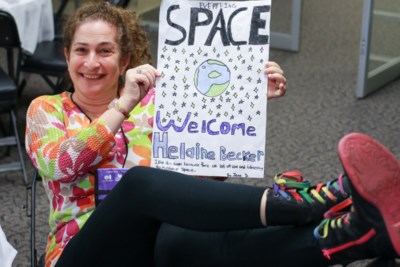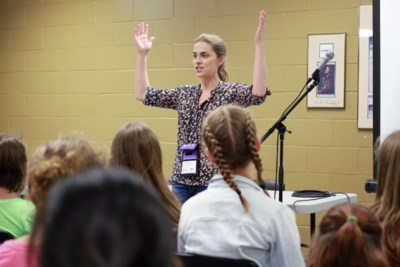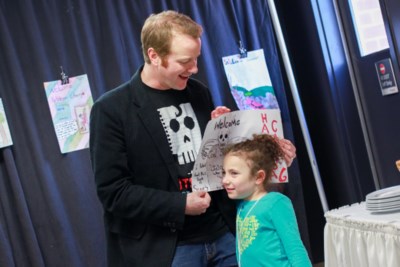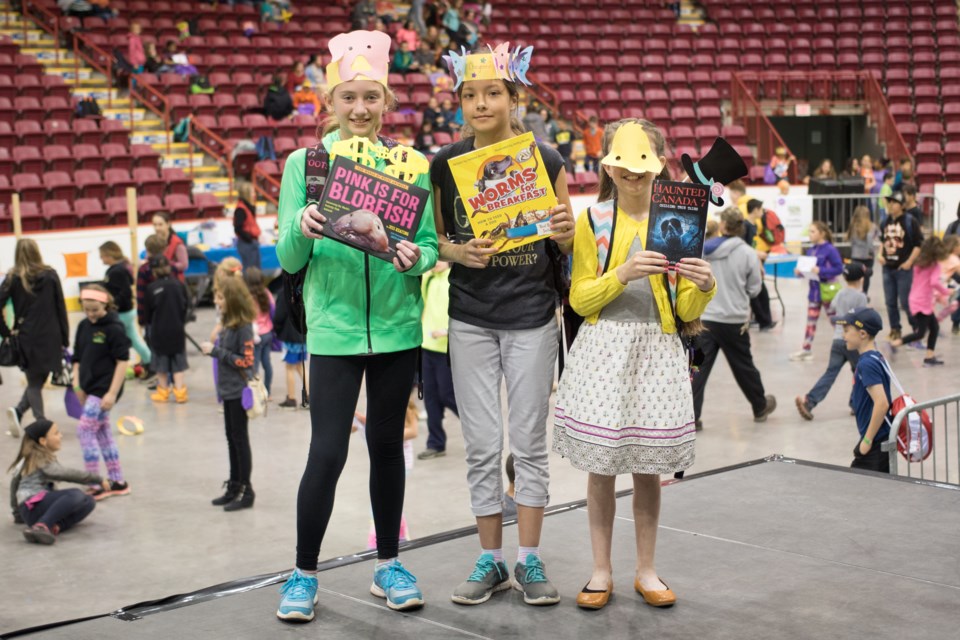Writing for children? The secret is to ‘be childish’ says best-selling Canadian non-fiction author Helaine Becker.
On Friday, several Canada's best selling children's book authors were in Sault Ste. Marie for the Forest of Reading’s Festival of Trees – not to be confused with the Lung Association of Algoma’s November festival of the same name.
SooToday spoke with three ‘children’s non-fiction’ authors who disclosed their writing secrets.
Helaine Becker – author of Worms For Breakfast
“I bet none of the other authors here write for children - we write for ourselves,” said Becker at Friday's event. “If you ask anyone what their mental age is – if they are a children’s writer their mental age will be something like 7, 11 , 14 - whatever it is, that tends to be very close to the age of the kids that they write for.”
 Children's author Helaine Becker at the Forest of Reading's Festival of Trees on May 19, 2017. Jeff Klassen/SooToday
Children's author Helaine Becker at the Forest of Reading's Festival of Trees on May 19, 2017. Jeff Klassen/SooTodayBecker’s book Worms for Breakfast is book of real recipes that zookeepers use to feed animals under their care.
The book appeals to children by being a bit wacky, a bit funny, and it includes lots of off-the wall facts – especially the recipes.
For example, ‘the platypus party mix’ recipe is essentially crayfish, earth worms, mealworms and fly pupaes mixed in a bowl – gross and interesting information that stimulates a child’s imagination.
“I sometimes talk to other adults and ask them about their childhood and they don’t remember very much and I find that strange. I remember everything so vividly. I can simply think about being five and I can try to go back to how I felt then. So, for me, it’s right there, it’s not put on. I don’t think you could put it on. I think kids feel it when its being put on – they feel they are being talked down to," said the author.
What’s 11-year old Helaine Becker’s world like?
“Mostly curious, I just want to explore everything. Lots of curiosity about the natural world; asking questions. It’s also about creativity. If I read something really interesting it gives me ideas and I want to see if I can create it myself. If I read a scary story I want to write one. Everything inspires everything else and everything feeds off of each other. It’s just a ferment of aliveness that hasn’t been squished yet by life. “
Jess Keating – author of Pink is for Blobfish
Jesss Keating’s book Pink is for Blobfish is a ‘motley crew of funny and non-fiction' that examines varieties of pink animals and other creatures in a way that makes kids rethink the idea the pink is ‘girly’.
“Pink can be a dangerous color, or a creepy colour, or a sly colour and I bring together a whole number of amazing animals that happen to be pink and I’m showcasing to people that pink can be so much more than what we think. I’m hoping by extension that we realize that maybe it’s not a good idea to limit people on how they look,” said Keating.
 Children's author Jess Keating at the Forest of Reading's Festival of Trees on May 19, 2017. Jeff Klassen/SooToday
Children's author Jess Keating at the Forest of Reading's Festival of Trees on May 19, 2017. Jeff Klassen/SooTodayWhen Keating was asked about her secret to writing children’s books, Keating said “be funny”, “be honest”, and “ look for as many opportunities to keep it as relative as possible to your reader.”
Humour is a big part of her work.
“My first step is keep it as funny as you can. We all love to laugh… so I think the big part keeping writing – especially nonfiction – relevant is approaching it from a child’s lens and bringing out some of your genuine reactions to it,” she said.
Can anyone be funny?
“I don’t think everyone has built-in funniness but I do think we have all experienced funny moments. If you can sort of flush those out you can... begin working at your own type of humour. I think the key to being funny is to not be someone else but to try to do what is innately funny to you.”
Joel A. Sutherland - author of Haunted Canada 6
Joel A. Sutherland wrote the fourth, fifth, sixth, and seventh titles in the ghost-story book series Haunted Canada and Haunted Canada 6 actually won the Silver Birch Award for Non-Fiction at this year’s festival.
Sutherland’s books are collections of real reported ghost sightings from across the country.
 Children's author Joel Sutherland with book-fan Catherine, 6, at the Forest of Reading's Festival of Trees on May 19, 2017. Jeff Klassen/SooToday
Children's author Joel Sutherland with book-fan Catherine, 6, at the Forest of Reading's Festival of Trees on May 19, 2017. Jeff Klassen/SooTodayEach book attempts to include at least one ghost story from each province and territory.
To gather his stories Sutherland said he reads books, old newspaper articles as well as “a lot of travelling by Google”.
Once he’s found a story he’ll get on the phone and try to find someone with a colourful firsthand account of a ghost encounter.
He said that his books will often detail a lot contextual information for the first-hand ghost stories and while readers may buy them to get spooked they are often getting an unexpected geography lesson or a lesson on Canadian history that includes facts about famous battles or characters like Emily Carr.
Sutherland was asked about the secret to writing good children’s non-fiction.
“I’ll tell you the secret – I won’t hold back,” said Sutherland. “It’s something I’ve developed over the course of the Haunted series, and by working very close with my editor. I think we’ve found it. First, I approach the stories, and even though they are real accounts – I still try and find whatever small element that makes the story stand apart from others“
"On top of that,” Sutherland added, setting up the second part of his writing secret. “When I start writing the story… I just don’t list the facts (but) I try and interview people and tell their story as if it’s a short horror movie. I try to get in their mind, figure out what they are feeling at the time, and what the temperature is, and try to weave in all these details that make it come alive for the reader. Instead of just the facts I try and get into the mindset of the people experiencing the paranormal activity,” he said.
The Forest of Learning Festival of Trees event happens every spring in at least Toronto and London, and often in a Northern location.
In years past that was Thunder Bay but starting last year it has been in Sault Ste. Marie.
The Toronto event draws around 12,000 children said organizers.
On Friday about 1,300 children attended the Sault Ste. Marie event at the Essar Centre.
When all three annual event locations are taken together, organizers say it is ‘Canada’s largest literary event for kids’.
Besides having children’s authors speak and give workshops, the Essar Centre was also full of high school musical performances, children’s games, and activities.
Helaine Becker will be speaking at the Centennial Library from 2-3 p.m. on Saturday.
